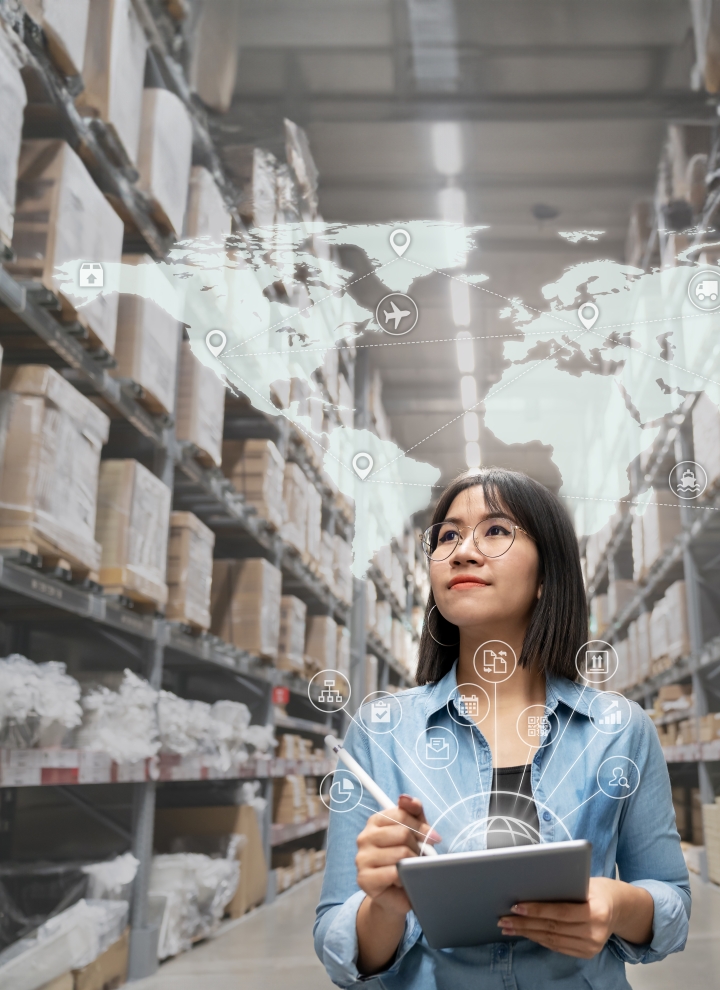
Building Resilience: How Digital Twins Deliver the Holy Grail of Connected Supply Chains

Listen to the blog here:
For CEOs of industrial manufacturing firms, one of the biggest concerns arising from the COVID-19 pandemic has been supply chain disruption. One study put the average cost to large businesses (those with revenues above USD 1bn) at around USD 184m in 2021.
Throughout 2020, the number of organizations experiencing 20 or more supply chain disruptions increased by a factor of six, according to the Business Continuity Institute’s 2021 Supply Chain Resilience report. This ranged from the Suez Canal blockage to container pileups in Shanghai and other major ports. If this wasn’t enough, ongoing climate change issues as well as geopolitical changes were the missing cherry on top. The same report found that the proportion of senior management showing a medium or high commitment to supply chain risk rose by nearly 10 percent to 82.7%. This goes to show that these global influences have the effect of transforming supply chains into revenue assurance drivers rather than cost reduction pillars.
Faced with this increasing volatility, uncertainty, complexity and ambiguity, the number one priority for sector leaders is to build resilience into the supply chain. Due to the pandemic leaders’ priorities shifting to business continuity and their realization that connectivity is the golden ticket, the challenge lies in a successful way to accomplish this.
The Holy Grail – connectivity across the supply chain
The global supply chain market is expected to experience a compound annual growth rate of 11.2% from 2020 to 2027 – a market value surge from USD 15bn to USD 37bn. With the added speed bump of supply chain disruptions, it’s time to build resilience into your supply chain, and business leaders are reaching for plentiful and readily available technological developments to do so. Currently, the IIoT-based solution showing the most potential when creating a resilient supply chain is the use of digital twins to mimic supply chains and productivity networks.
In recent years, the digital transformation of supply chains has made them increasingly dynamic and complex. Catalyzed by the pandemic and other previously mentioned supply chain hurdles, manufacturers have sought out new ways to optimize supply chains to ensure transparency. To do so, in-depth understanding and visibility of the entire end-to-end ecosystem of suppliers and customers – their needs, strengths, weaknesses and potential risk factors – is the Holy Grail.
This ideal of a fully connected ecosystem providing real-time data starts by connecting your own supply chain. Only once you have complete visibility of your own end-to-end operations, connection with the wider ecosystem can be achieved, enabling you to create a holistic overview and transparency from customer to supplier.
Based on this holistic overview, you need to decide on your own business goals and adjust your digitalization strategy accordingly. Easier said than done? Not necessarily. The important thing is not to drown in the ocean of possibilities and to keep your eye on your business goals, letting them dictate the level of detail your digital solution requires.
Digital twins – the kick starter for connected supply chains
It’s estimated that up to 93% of all IoT Platforms will contain some form of digital twin capability by 2027. So what exactly is a digital twin? And how does it tie in with a connected supply chain? To put it simply, a digital twin is a virtual representation of a physical product or process. By feeding it with data, it can be used to model the current situation in real time, test ‘what if’-scenarios for the future and, in some instances, even provide ‘best practice’ to the modelled disruption. As such, it provides predictive insights, highlights areas of weakness or potential failure and enables timely preventative action.
By incorporating the latest technical innovations (eg multi-physics simulation, AI, data analytics and machine learning), digital twins can demonstrate the impact of usage scenarios, environmental conditions and other variables to improve the resilience of a supply chain. The digital twin is therefore the ultimate goal in connecting your supply chain, yet you need to learn to walk before you can run. Start by determining the digital journey most adequate for reaching your business' set goals and drivers. Luckily, there are a few maturity levels you can reach before chasing the Holy Grail of the digital twin, and there is likely a data solution for every organization and budget.
To provide visibility and transparency on an operational level, applying a digital map or model might suffice, as it provides basic insights into your operations. However, if you want to leverage data to simulate and explore various possible scenarios and the effects of changes before implementing them in the physical supply chain, a digital shadow might be the best approach. However, only a digital twin can create enough insights to enable real-time connection and provide concrete simulations for operational, tactical as well as strategic decision making.
How to implement a digital twin fit for your goals
The key to realizing this ideal scenario is leveraging the correct data in the correct way by the correct people. However, as with any form of digitalization, there are several factors to consider when starting the journey to executing a digital twin.
Firstly, it’s crucial to always have your goals in mind: the business outcome you want to achieve should be the foundation for your decision as to which data model to use. For certain organizations, it may not be necessary to apply an end-to-end digital twin at the very beginning of your digital transformation journey. Trying to navigate through the buzzwords and promises from solution providers and staying true to your core needs is therefore an important first consideration. Applying technology just for the sake of applying technology is never the solution!
Secondly, a digital twin is only as good as the data it gets fed. Therefore, you need to gather useful data and that’s the tricky part. When creating the digital twin, connecting your internal data is advised, as this is the data that’s readily available to you. However, it’s important not to fall into the trap of data overload, which can result in too many insights slowing down and clouding the decision-making process. Once you have an internal connected supply chain in place, you can start reaching out to your ecosystem to further increase connectivity. It’s essential to take the time to understand relevant data management solutions for your business goals and ecosystem.
Everybody knows that data is the new gold in business, and companies are often reluctant to give it up lightly. This results in a potentially complex process of connecting your full ecosystem, as you need to convince all stakeholders about the joint value that can be created through sharing knowledge and creating transparency. As soon as they’re fully connected and sharing their data, you can collectively create the most detailed digital model possible, which will benefit everybody along the chain.
However, in reality it’s unlikely that every member of your ecosystem will share the data needed to simulate a complete supply chain digital twin, but that does not mean the end of the line for your digital twin journey. The good news is that there is a sophisticated workaround to help you overcome this particular roadblock: artificial intelligence (AI). Through AI, it’s possible to model the missing data and thus fill in gaps in your data lake. Furthermore, other data sources can be fed into AI to derive expected impacts to the supply chain from striking events, for example the news of a flooding in a particular region in the world can be overlaid with your supplier base and the digital twin can preempt potential impacts and solutions.
Everybody knows that data is the new gold in business, and companies are often reluctant to give it up lightly.
Making the process match the insight
Now that your data is in place and connected, the true benefit of a digital twin emerges. Real time connection and seamless data flow will enable direct transparency of your data, and customized visualization, dashboards and alerts will allow for rapid decision making. The only question is, will your decision-making processes be able to keep up with this increased speed of knowledge?
Data digitalization and process optimization need to be harmonized, as data without a process is useless, and a process without data is inefficient. Future supply chains will be a combined learning network of humans and technology, so alongside building your digital twin, it’s important to invest in the creation of a flexible workforce willing to adapt its skillset to facilitate a bionic supply chain. After all, the most powerful intelligent network is still the human mind, and it’s fundamental in deriving and acting on the benefits of a supply chain digital twin.
Enabling and benefitting from the factor of the future
When applying connected supply chains in the industrial manufacturing environment, it is important to shed light on how their connection to the green, lean, and digital factories of the future will look like. In this specific context, the successful creation of supply chain digital twins depends on the quality of data from every factory, warehouse, or nod within the supply network. This means that it is best practice to successfully develop digital twins of your factory in the first place. This will make the trick for the whole network as data could be provided seamlessly.
At the same time, it is crucial to understand that the factory of the future and its successful operations heavily depend on seamless data flows, processes, connectivity, and agility on a large scale in order to ensure individual productivity, robustness, and delivery excellence. Ever changing markets, customer requirements and supply disruption can only be managed sustainably by building agility and reactiveness into the mix. The supply chain digital twin can be the dealmaker in this context enabling the transparency needed beyond one’s own facilities. In the end, the factory of the future, being green, lean and digital in nature, is both enabler and benefactor from the creation of a supply chain digital twin. Seamlessly, connected supply chain can build the basis for factories and whole networks to decarbonize operations.
Unlocking the potential of supply chain digital twins
Increased connection and digitization open the possibility of creating supply chain digital twins, but it’s not actually the digital twin that creates the value for your business. A digital twin is simply the vehicle you need to enable a fully connected supply chain, and the strategic connection with your individual business goals is the key that makes your vehicle perform. As a result, your entire ecosystem will gain a competitive advantage.
Siemens Digital Industries Logistics (DI LOG) has already paved the way towards a comprehensive digital supply chain twin with their end-to-end resilience solution. This platform helps both Siemens and its partners to proactively manage supply chain and operations based on real time tracking and data-driven alerting functionalities for all involved parties within the network.
Free whitepaper
Based on our unique experience in digital factory environments, we identified several company as well as use case specific factors to make the groundbreaking decision between edge and cloud. Download our whitepaper and learn which factors to consider when unlocking the full potential of your IIoT journey!
Our experts




 Contact Us
Contact Us